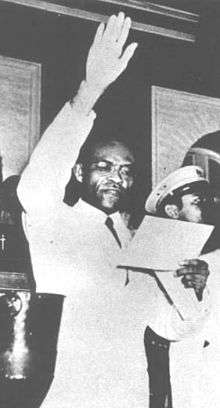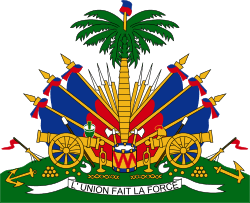Dumarsais Estimé
| Dumarsais Estimé | |
|---|---|
 Dumarsais Estimé taking the oath of office in August 1946 | |
| President of Haiti | |
|
In office 16 August 1946 – 10 May 1950 | |
| Preceded by | Franck Lavaud |
| Succeeded by | Franck Lavaud |
| Minister of National Education, Agriculture and Labor | |
|
In office 29 November 1937 – 5 January 1940 | |
| President | Sténio Vincent |
| Preceded by | Auguste Turnier |
| Succeeded by | Luc E. Fouché |
| Personal details | |
| Born |
Léon Dumarsais Estimé 21 April 1900 Verrettes, Haiti |
| Died |
20 July 1953 (aged 53) New York City, New York, United States |
| Nationality | Haitian |
| Political party | Independent |
| Spouse(s) | Lucienne Heurtelou (m. 1939–53) |
| Children | Léon Jean-Robert Estimé, Paul Dumarsais Estimé |
| Profession | Lawyer, teacher |
Léon Dumarsais Estimé (21 April 1900 – 20 July 1953) served as the President of Haïti from 16 August 1946 until 10 May 1950. He was the first black head of state since the US occupation of Haiti ended in 1934.
Early life
Estimé was born to a poor family in the small city of Verrettes. A well-to-do uncle, Estilus Estimé, brought him to Port-au-Prince, Haiti's capital, and financed his education at law school. He graduated and briefly practiced law before becoming a teacher. After the government of Louis Borno expelled him for sedition, Estimé joined Haiti's nationalist movement in 1930 and became an outspoken opponent of the United States occupation of Haiti.
Estimé developed a reputation as a skillful and competent civil servant, becoming one of the few black members of the Haiti's lower chamber of Parliament. Marrying into and allying with elements of Haiti's mulatto elite, he rose through the ranks of the government of Sténio Vincent and eventually became Minister of Education. An unsuccessful bid for the Haitian presidency in 1941 did not temper his political ambitions. Unlike other prominent political leaders, he was not part of the opposition that eventually sparked a successful uprising against the government of Élie Lescot.
A seven-month period of political wrangling under an interim military-led government drew to a close with the election of Estimé in August 1946, the first black president of Haiti since the US occupation ended in 1934.
Initially, his administration included a coalition of dissidents who led opposition to previous regimes. But Estimé learned the United States viewed his government unfavorably as radically left-wing. As the coalition broke up, fiery labor leader Daniel Fignolé and socialist George Rigaud were eased out of the cabinet. Estimé would later attempt to solidify ties to the United States by exaggerating the communist threat to his government.
Estimé's noiriste government represented a significant departure from previous administrations. Government jobs, including cabinet positions, were overwhelmingly held by black professionals instead of members of the light-skinned elite. The head of the cabinet, Roger Dorsinville, was an impassioned black nationalist who authored Estimé's inaugural speech calling for broad reforms and empowerment of the Haiti's poor masses.
Education policy included the building of provincial schools and expanded training for teachers, leading to a 45-percent increase in primary school enrollment. Road-building, literacy campaigns, a national census, and rural development campaign were elements of a broad expansion of social programs.
Pledges of greater protections for workers were reflected in the creation of a new labor bureau and the inclusion of workers' organizing rights in the new constitution. The government held an unprecedented national labor conference in 1949 and increased the daily minimum wage.
This led to increased migration of the unemployed into Port-au-Prince, who expected new government jobs, burdening the already over-populated capital city. As time wore on and with the state reaching for total control over the labor sector, independent unions became hostile to the regime.
Economic policy
Despite his set of programs, Estimé was largely unable to deliver on his promises of economic liberation.
His government was hampered by the previous administration's 1941 accord with the United States, which imposed strict tax controls and allowed for interference in the national budget. A 1947 delegation to Washington, D.C. decried the Export-Import Bank's refusal to forgive and delay dues on millions of dollars of outstanding debts, including those accrued during the United States occupation.
In Haiti, large American firms such as the rubber-development company SHADA likened labor officials to "communists." Estimé placed the board of Haiti's national bank, previously made up of three US representatives and two Haitians, under total Haitian control.
Desperately short of funds to finance his reforms, Estimé issued an extraordinary call to the Haitian people to sacrifice and help raise money. "With them or without them we will liberate the country," he told radio listeners in a 1947 national address, referring to the US refusal to forgive debts. A popular national campaign saw senators accept reduced salaries and donations flow to the government. Five million of an unprecedented internal loan of $7.6 million went towards debt payment.
The US government, worried about increasing anti-American sentiment in Haiti, later issued a loan of $4 million and began development support programs for the Artibonite Valley, tourist industry, and adjustment of SHADA debts.
Estimé's nationalization of the Standard Fruit Company, part of the thriving banana sector in the countryside, became a disaster. The government's equipment was inadequate and peasant farmers lost critical agriculture support. By 1949, after a severe drought the previous year, the industry was plagued with debts. Corruption, as in much of the Estimé administration and the new black elite class, was widespread. Estimé organized an extravagant $4 million (out of a $13.4 million national budget) carnival celebration called the Exposition in 1950.
Decline and overthrow
Haiti's mulatto elite was in a state of constant conflict with the Estimé regime, which it saw as discriminatory against light-skinned people. From below, labor leader Daniel Fignolé attacked Estimé for not going far enough to empower poor blacks.
But elements of the Haitian Army proved the greatest threat to Estimé's government. The Army joined forces with President Rafael Trujillo from the neighboring Dominican Republic in an open attempt to unseat Estimé, prompting the government to declare a national state of siege in 1949. Over the next year, Estimé gradually lost his grip on power – the Senate, political dissidents, the military, and even many noiristes turned against him. A last-ditch attempt to extend his term, break up opposition by mob attacks and dissolve political bodies failed, as did pleas to the US government to support him. Estimé signed a letter of resignation and was exiled to Paris in May 1950.
Estimé died of uremia at Columbia Presbyterian Hospital in New York City on 20 July 1953.[1][2] His wife was killed in a Port-au-Prince jewelry store shooting in July 2005.[3]
References
- ↑ "Dumarsais Estimé". Toledo Blade (Google News). Associated Press. 21 July 1953. Retrieved 12 October 2015.
- ↑ "This Week's Census". Jet. Johnson Publishing Company. 4 (13): 26. 6 August 1953. ISSN 0021-5996.
- ↑ Charles, Jacqueline (15 August 2005). "Slain Haitian icon to be honored". Miami Herald. Retrieved 12 October 2015.
- Smith, Matthew J. Red & Black in Haiti: Radicalism, Conflict, and Political Change, 1934–1957. Chapel Hill: University of North Carolina Press, 2009.
| Political offices | ||
|---|---|---|
| Preceded by Franck Lavaud |
President of Haiti 1946–50 |
Succeeded by Franck Lavaud |
